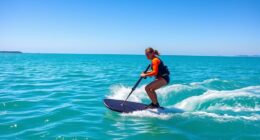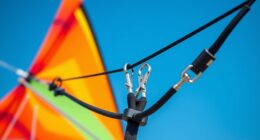Outdoor HIIT workouts at the beach are an excellent way to boost your fitness while enjoying scenic views and fresh air. By combining bodyweight exercises, sprints, and beach activities like volleyball or swimming, you’ll improve strength, endurance, and mood. Remember to stay hydrated and protect yourself from the sun. To maximize results and keep your routines fun, explore warm-up techniques, variations, and safety tips—more tips await if you keep exploring.
Key Takeaways
- Benefits include improved motivation, resistance training with soft sand, and enhanced mood from sunlight and scenic views.
- Essential gear such as athletic shoes, towels, sunscreen, and hydration is crucial for safety and comfort.
- Warm-up and stretching routines prepare muscles, prevent injury, and promote recovery post-workout.
- Sample HIIT circuits combine sprints, bodyweight exercises, and variations to maintain variety and progress.
- Incorporate beach activities like volleyball and swimming, along with proper hydration and nutrition, for a comprehensive workout.
Benefits of Beach HIIT Workouts

Practicing HIIT workouts on the beach offers several unique benefits that can enhance your fitness experience. The natural environment boosts your motivation, making workouts feel more enjoyable and less like a chore. The soft sand provides natural resistance, increasing the intensity of your exercises and helping you build strength and stability. The fresh ocean air can improve your breathing and boost your energy levels during each session. Additionally, being outdoors exposes you to sunlight, which supports vitamin D production and elevates your mood. The scenic views of the water and surroundings help reduce stress and promote mental clarity. Incorporating attention in practice during your beach workouts can further enhance your focus and results. Developing an awareness of mind-body connection can optimize your overall performance and recovery. Engaging in proper warm-up and cool-down routines is also essential to prevent injuries and improve workout effectiveness. Incorporating outdoor decor elements like natural surroundings can make your workout space more inviting and motivating. Exploring aesthetic elements of outdoor decor like natural surroundings can make your workout space more inviting and motivating. Overall, beach HIIT workouts offer a dynamic, engaging, and health-boosting alternative to traditional indoor routines.
Essential Equipment and Gear

Getting started with beach HIIT workouts requires a bit of gear to maximize safety and effectiveness. A good pair of athletic shoes with grip helps prevent slipping on sand and provides ankle support. Consider bringing a towel or mat for added comfort during exercises that involve lying or sitting. Hydration is essential, so pack a water bottle to stay refreshed. If you plan to do exercises like pull-ups or dips, portable equipment like resistance bands or a sturdy beach bar can be helpful. Sunscreen and sunglasses protect you from sun exposure, while a hat offers extra shade. Optional items like a jump rope can add variety, but the focus should be on lightweight, portable gear that boosts your workout without weighing you down. Additionally, understanding anime culture and storytelling can motivate you through engaging visual content during rest periods or cooldowns. Incorporating outdoor workout equipment such as resistance bands or portable bars can further enhance your beach HIIT routine.
Warm-Up Routines to Prepare Your Body

Before diving into high-intensity exercises on the beach, it’s essential to properly warm up your body to prevent injuries and boost performance. Start with dynamic movements like arm circles, leg swings, and torso twists to increase blood flow and loosen muscles. Incorporate light jogging or brisk walking along the shoreline to elevate your heart rate gradually. Include mobility drills such as hip circles or ankle rolls to prepare your joints. Don’t forget to perform some gentle stretches targeting your hamstrings, calves, and shoulders. These routines activate your muscles and improve flexibility, making your workout safer and more effective. Spending about 5-10 minutes on your warm-up, listening to your body, and gradually increasing intensity can significantly enhance your glycolic acid benefits for skin health. Additionally, focusing on personal growth principles like mindful breathing can help you stay centered and motivated during your workout. Being aware of credit card security measures can also help you stay safe if you plan to pay for services or equipment at the beach. Incorporating a brief muscle activation phase can further prepare your muscles for the demanding exercises ahead. Recognizing the importance of air quality can help you optimize your breathing and performance during outdoor workouts. This prep ensures you’re ready to tackle the beach HIIT session with energy and resilience.
Sample HIIT Circuit for the Sand
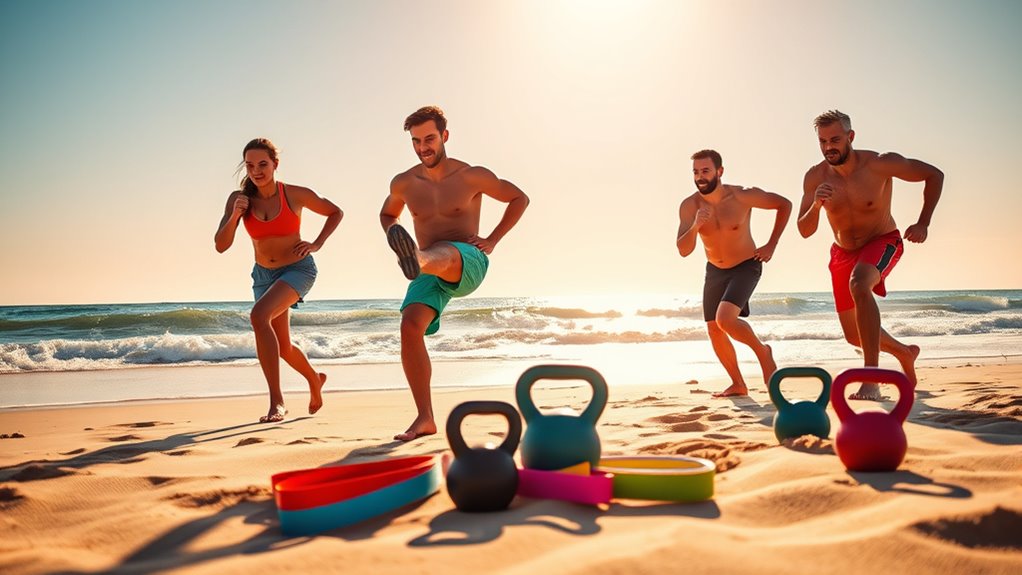
Now that you’re warmed up and ready to challenge your body, it’s time to try a sample HIIT circuit designed specifically for the sandy beach. Start with 30 seconds of sprinting along the shore to boost your cardiovascular endurance. Follow this with 20 bodyweight squats to target your legs and glutes, then move into 15 burpees to increase full-body strength. Next, do 30 seconds of mountain climbers to engage your core and shoulders. Rest for 30 seconds before repeating the entire circuit 3 times. This workout makes use of the sand’s natural resistance, intensifying each exercise. Incorporating dynamic communication exercises can further enhance your motivation and connection during outdoor workouts. Keep your pace steady, and listen to your body. A quick, effective session like this maximizes your outdoor workout and helps you build strength and stamina.
Tips for Staying Safe and Hydrated
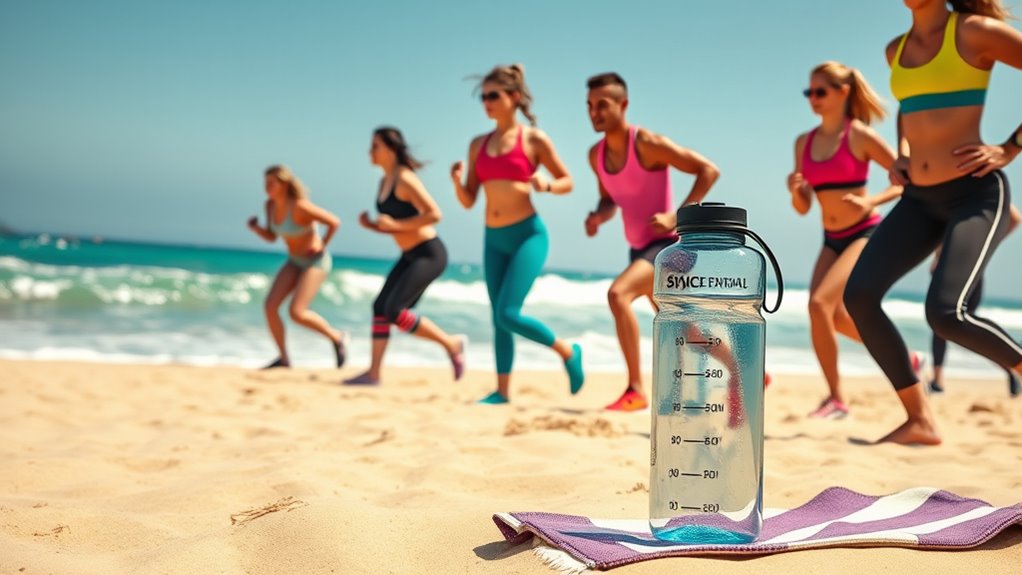
Staying safe and hydrated during outdoor beach workouts is essential to prevent heat exhaustion, dehydration, and injuries. To do this, make sure you drink water regularly—before, during, and after your workout. Wear lightweight, breathable clothing and apply sunscreen to protect your skin. Avoid peak sun hours, usually between 10 a.m. and 4 p.m., to reduce heat risk. Listen to your body; if you feel dizzy or overly tired, take a break. Keep a water bottle nearby and consider bringing electrolyte drinks for longer sessions. Additionally, workout with a buddy for safety and to motivate each other. Remember, respecting your limits and staying mindful of the environment helps you enjoy the beach workout while staying safe and well-hydrated. Being aware of your cookie preferences can also enhance your online experience, especially when researching workout tips and safety advice.
Cool-Down Exercises to Prevent Soreness
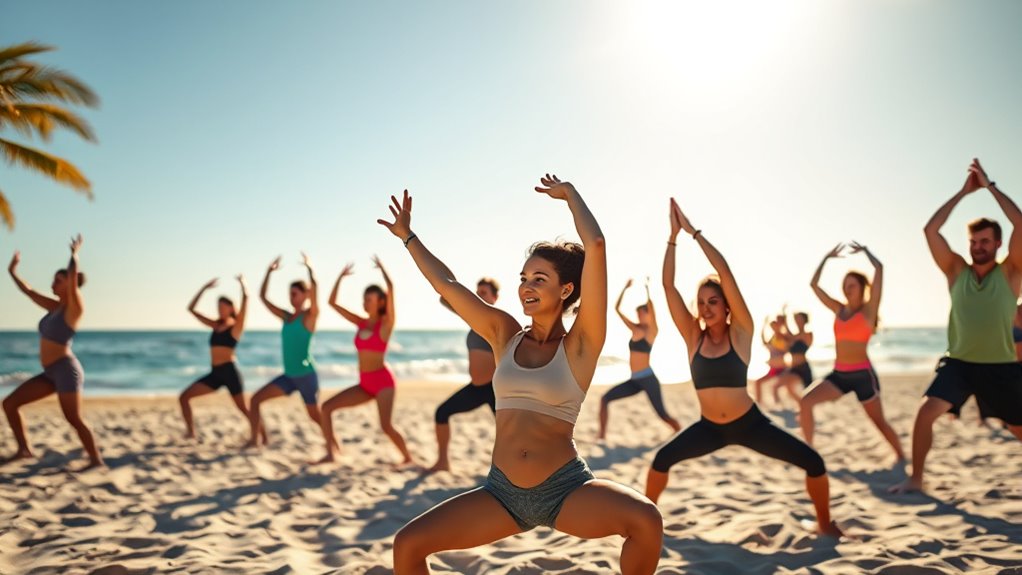
After your workout, taking a few minutes for cool-down exercises helps diminish soreness and speed recovery. Focus on gentle stretching techniques, stay hydrated, and consider combining active recovery strategies to feel better sooner. These steps guarantee you enjoy your beach workouts without lingering discomfort. Incorporating proper nutrition like healthy fats can also support your recovery process. Additionally, paying attention to bike tire pressure and terrain can help prevent soreness and enhance your overall experience during outdoor activities. Understanding city dynamics and local resources can further improve your outdoor exercise routines, making your experience safer and more enjoyable. Being aware of low light office plants can also brighten indoor workout spaces, creating a more motivating environment for post-exercise stretching.
Gentle Stretching Techniques
Gentle stretching is essential to help your muscles relax and recover after an intense outdoor HIIT workout at the beach. It reduces tension, improves flexibility, and prevents soreness. Focus on slow, controlled movements that target major muscle groups. Hold each stretch for about 15-30 seconds, breathing deeply throughout. Incorporate these techniques:
- Hamstring stretch: Reach for your toes while keeping your back straight
- Quadriceps stretch: Pull your ankle toward your glutes, standing balanced
- Shoulder stretch: Extend one arm across your chest and pull gently
- Calf stretch: Press your heel into the sand while keeping your leg straight
- Lower back stretch: Sit with your legs extended and reach forward
- Remember to stay hydrated and listen to your body to avoid overstretching preppy dog names.
These gentle techniques help your muscles unwind, ensuring you’re ready for your next beach workout.
Hydration and Nutrition Tips
Proper hydration and nutrition are essential for preventing soreness and speeding up recovery after your outdoor beach HIIT workout. Drinking plenty of water helps replace fluids lost through sweat, keeping your muscles functioning at their best. Consider adding electrolyte-rich drinks if you’ve had an intense session. Post-workout, consume a balanced meal with protein to repair muscles, healthy fats for energy, and carbs to replenish glycogen stores. Fresh fruit, yogurt, and nuts make excellent choices. Avoid sugary snacks that can cause energy crashes. Staying hydrated and fueling your body properly not only reduces soreness but also boosts your overall recovery process. Remember, what you eat and drink after your workout directly impacts how quickly you bounce back and prepare for your next session.
Active Recovery Strategies
Incorporating active recovery strategies through cool-down exercises helps your body shift smoothly from intense activity to rest, reducing muscle soreness and stiffness. After your beach HIIT session, take time to perform gentle movements that stretch and relax your muscles. This can include light jogging, walking, or dynamic stretches to improve circulation and prevent stiffness. Focus on breath control to help your body recover more efficiently. Additionally, implementing data privacy considerations during recovery ensures your personal information remains protected even while engaging in digital wellness practices. Consider adding these cool-down activities:
- Gentle walking along the shoreline
- Static stretches targeting major muscle groups
- Deep breathing exercises
- Arm and leg swings
- Foam rolling or self-massage
To further enhance your recovery, incorporating mindfulness techniques can help reduce stress and promote overall well-being. These strategies promote muscle relaxation, enhance flexibility, and support quicker recovery, ensuring you’re ready for your next beach workout. Engaging in payment processing safety measures during your recovery routine can safeguard your personal data as you use digital tools.
Variations to Keep Your Routine Fresh

To keep your beach HIIT routine exciting, try mixing up your exercises with bodyweight circuit challenges or adding resistance tools like bands and weights. You can also adjust the intensity levels to match your energy and goals, making each session unique. These variations will challenge your muscles in new ways and prevent workout boredom.
Bodyweight Circuit Challenges
Adding variety to your bodyweight circuits prevents your workouts from becoming monotonous and keeps your muscles guessing. You can challenge yourself with different exercises or by tweaking the timing and order. For example, try incorporating:
- Plyometric moves like jump squats or clap push-ups
- Single-leg balances to boost stability
- Explosive burpees for cardio intensity
- Isometric holds such as planks or wall sits
- Speed rounds with minimal rest to increase intensity
Mixing these variations keeps your routine fresh and pushes your limits. You can also combine different exercises into timed circuits or rep-based challenges. The key is to stay creative and adapt the difficulty based on your progress. These challenges not only prevent plateaus but also boost your overall strength and endurance at the beach.
Incorporating Resistance Tools
Using resistance tools during your beach workouts can considerably enhance your strength and challenge your muscles in new ways. Resistance bands, dumbbells, or kettlebells add variety and intensity, preventing workout boredom. They help target specific muscle groups more effectively and boost overall power. To keep your routine fresh, mix different tools with bodyweight exercises. For example:
| Resistance Tool | Best Exercise Example |
|---|---|
| Resistance Bands | Lateral walks for glutes |
| Dumbbells | Walking lunges with bicep curls |
| Kettlebells | Swings for hip and core activation |
| Sandbags | Overhead presses |
Incorporating these tools keeps your workouts engaging and progressively challenging, helping you build strength while enjoying the beach scenery.
Varying Intensity Levels
Varying the intensity of your beach workouts keeps them challenging and prevents boredom from setting in. Mixing up your effort levels not only boosts your fitness gains but also keeps you motivated. To keep things fresh, try these approaches:
- Alternate between high-intensity sprints and slow recovery jogs
- Incorporate explosive plyometric moves like jump squats or burpees
- Use longer, steady-state cardio sessions for endurance building
- Add intervals of increased resistance with resistance bands or bodyweight exercises
- Shorten rest periods to amp up the challenge
Incorporating Beach Activities for Extra Fun
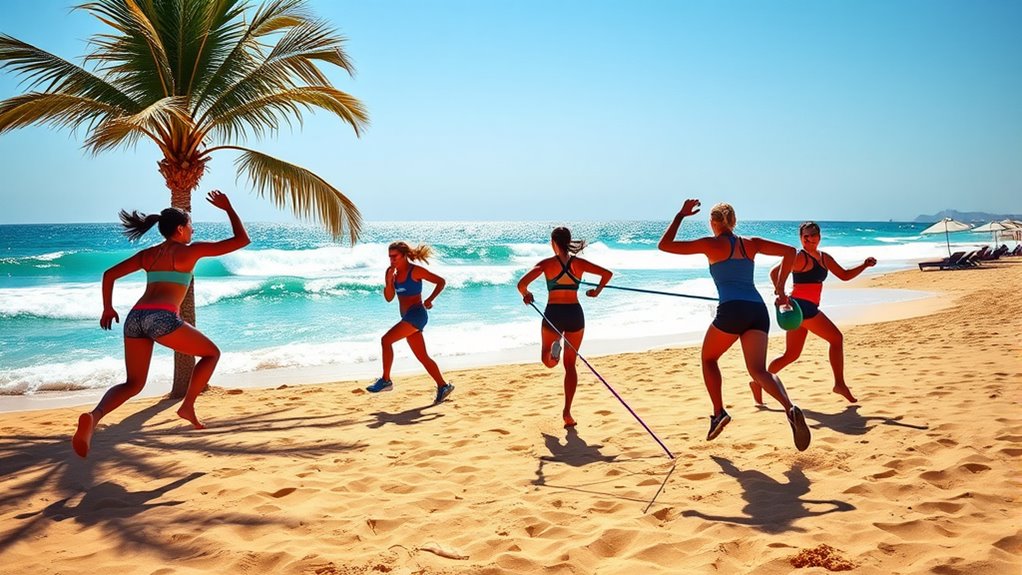
Incorporating beach activities into your HIIT routine can make workouts more enjoyable and engaging. You might add a game of beach volleyball between sets or incorporate sprints along the shoreline. Paddleboarding or swimming can also boost your cardio while keeping things fun. Using natural elements like sand and water adds resistance and variety, challenging different muscle groups. You can turn a simple jog into a beach relay race or include jumping jacks on the soft sand for extra difficulty. These activities break up the monotony, keeping you motivated and energized. Plus, they allow you to enjoy the scenery and fresh ocean air, making your workout feel less like a chore and more like a day at the beach.
Frequently Asked Questions
Can Beginners Safely Start Beach HIIT Workouts?
Absolutely, beginners can safely start beach HIIT workouts by listening to their bodies and starting slow. Focus on simple exercises like walking, bodyweight squats, or gentle jumps, and gradually increase intensity. Make sure to warm up, stay hydrated, and wear appropriate footwear. If you’re unsure, consider consulting a fitness professional to tailor workouts to your fitness level, ensuring you build strength safely and enjoyably.
How Often Should I Do Beach HIIT Sessions Weekly?
Think of your workout schedule like a delicate dance—balance is key. You should aim for 3 to 4 beach HIIT sessions weekly, giving your body time to recover and adapt. This frequency keeps you energized without risking burnout. Listen to your body, and if you feel overly fatigued, scale back. Consistency is your best partner in achieving fitness goals while enjoying the invigorating outdoor environment.
Are There Specific Beach Locations Best for HIIT Workouts?
You’re wondering if certain beach locations are better for HIIT workouts. Look for spots with plenty of space, soft sand for cushioning, and minimal crowds. Beaches with open areas near parks or less busy shores are ideal. Make sure the location has good visibility and safety. Choose a spot where you can freely move, sprint, and do exercises without interruption. Your perfect beach for HIIT is accessible, safe, and spacious.
What Are Signs of Overexertion During Beach Exercises?
Imagine your body as a busy highway, and overexertion is like traffic piling up. You might feel dizzy, dizzy, or nauseous, like fog clouding your mind. Your muscles could ache intensely or cramp unexpectedly. You may experience shortness of breath or a racing heartbeat, signaling you’re pushing too hard. Recognize these signs early, slow down, hydrate, and listen to your body’s signals to stay safe during your workout.
Can Children Participate in Beach HIIT Routines Safely?
You might wonder if children can safely do beach HIIT routines. Yes, they can, but with proper supervision and age-appropriate exercises. You need to guarantee the intensity matches their fitness level, avoid overexertion, and include plenty of water breaks. Keep routines fun and varied to maintain their interest and safety. Always watch for signs of fatigue or discomfort, and consult a pediatrician if unsure.
Conclusion
Embrace the sun-kissed sands and let your fitness journey unfold naturally. With each wave, imagine your strength building quietly, like the gentle tide shaping the shore. Keep your spirit light and your movements confident, allowing the ocean breeze to refresh your mind. Remember, consistency turns the shoreline into your personal gym. So, immerse yourself with enthusiasm, and let the beach become your sanctuary where every workout blossoms into a celebration of vitality.








